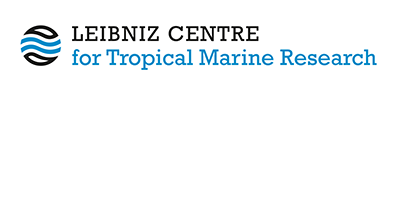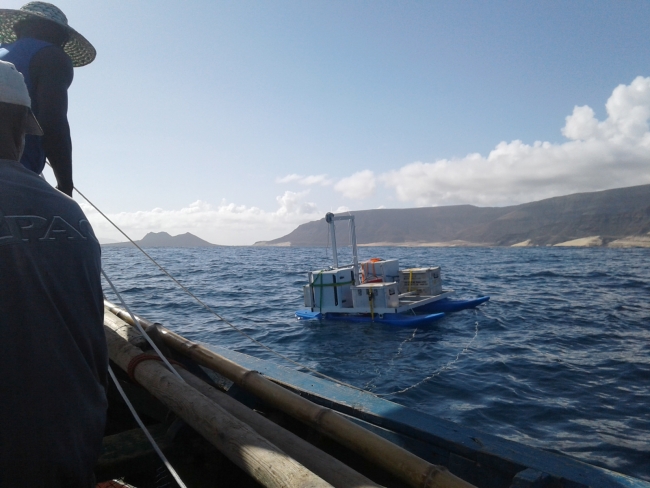05.10.17 | Until mid-October, a group researchers including scinetists from the Leibniz Centre for Tropical Marine Research (ZMT) are investigating the path of organic particles from the ocean to the atmosphere to learn more about their effect on clouds and the climate. Samples are taken daily from the ocean and air and compared with a laboratory experiment on site. The investigations on the Cape Verde Islands are the central field campaign of the MarParCloud project, in which the Leibniz Institute for Tropospheric Research (TROPOS), the Leibniz Institute for Baltic Sea Research (IOW) and the Leibniz Centre for Tropical Marine Research (ZMT) are cooperating with the Universities of Oldenburg and Hamburg. Furthermore, researchers from the institutions IRCELYON and ICARE from France as well as Chinese researchers from the Fudan and Shandong universities are on site during the measurement campaign. The aim of the cooperation is to explore the entire process chain of organic material: from primary biological production in the ocean and transfer into the atmosphere to the effect on cloud formation. The investigations are funded by the Leibniz Association and the European Commission within the framework of the EU project MARSU (MARine Atmospheric Science Unravelled) within the framework of the Leibniz Competition.
The surface of the ocean is one of the largest and most important interfaces of our planet with 362 million square kilometres. Sunlight, heat, nutrients and pollutants enter the sea through its surface. Conversely, seawater also releases energy, gases and particles to the air above. These two spheres are separated by an extremely thin surface film. Even though the seas and oceans cover around 71 percent of the earth and play an important role for weather and climate, many questions remain unanswered regarding the surface film. Climate research is also hoping for answers from studies such as those currently being conducted on the Cape Verde island of São Vicente. São Vicente is located about 600 kilometres off the west coast of Africa in the trade wind zone of the Atlantic Ocean. The trade winds transport millions of tons of dust from the Sahara to the west every year. To investigate this dust, the Cape Verde Atmospheric Observatory (CVAO) was established on a cliff above the sea. For the last ten years, TROPOS has been measuring dust by collecting filter samples, which are analysed later in Leipzig.
“While during the winter months, the wind comes from the Sahara, in late summer we can also investigate more aerosol particles of marine origin," said campaign leader Dr Manuela van Pinxteren from TROPOS. So it is the perfect time to take a closer look at processes that take place directly between the ocean and the atmosphere. During these months, a stable cloud often forms on Monte Verde, the highest mountain of the island. We have installed particle and cloud water collectors on the mountain to check which substances are migrating from the ocean to the clouds," said van Pinxteren from the Department of Atmospheric Chemistry. In addition to the filter samples and cloud water samples for the chemical analysis of particles in the air, further extensive measurements are now being taken at São Vicente: every day, the team goes out on a boat to take samples from the ocean. The water is then transferred in bottles to the laboratory. In order to capture the surface film, a thin glass plate was previously dipped into the water and slowly pulled out again. The micrometre-thick surface film adheres to the glass surface, is wiped off with a Teflon wiper and frozen to stop chemical conversion processes. This technique has already proven to be successful on various expeditions of the research vessel Polarstern. On this campaign, however, the surface film is not collected manually, but rather using a catamaran specially designed by the ZMT for this purpose. This means that larger quantities of the ultra-thin layer can be obtained in a short period of time, which are then available for the various analyses. After successful tests off the German coast, the catamaran is now being used for the first time in the tropical Atlantic Ocean.
Researchers from the Department of Aerosol and Cloud Microphysics at TROPOS are interested in the possible effects of particles from the ocean on the formation and properties of clouds. For this purpose, instruments were installed on São Vicente to detect and characterise aerosol particles, cloud droplets and ice germs. Ice germs are particles that can cause the formation and freezing of cloud droplets. The team operates two identical instrument sets on the coast (at the CVAO) and more than 700 metres higher on Monte Verde, which are already providing initial results. Furthermore, a complementary kite and tethered balloon platform is being used to investigate the condition of the atmosphere by measuring wind speeds, temperatures and humidity. We have already found clear evidence that there is a connection between the properties of aerosol particles, cloud droplets and ice germs at sea level and at the cloud level at this site," said Dr Frank Stratmann, head of the department of Aerosol and Cloud Microphysics." He went on to say: "This is one of the basic prerequisites for the possible influence of particles from the surface film on clouds. However, this is not yet proven.
”Quite unusual for atmospheric research is the use off a water tank about one cubic metre in size, in which fresh seawater is pumped and breaking waves are simulated. The properties and constituents of the aerosol particles from the tank are directly compared with those of the particles in the outside air to determine similarities and differences. Thus, processes in the marine atmosphere can be compared with those in small scale under controlled conditions. The team had already carried out tests in the seawater test facility of the ZMT in Bremen and in the seawater basins of the University of Oldenburg.
French and Chinese research colleagues have also brought their scientific equipment to the tropical island. Among other things, they are using a small laboratory chamber to investigate whether gaseous substances form measurably small aerosol particles from the surface film. Furthermore, they are carrying out continuous in-situ measurements of nitrous acid in the gas phase with a so-called "LOPAP". LOPAP (LOng-Path AbsorPtion) is a very sensitive technique for the measurement of nitrous acid (HNO2), which plays an important role in chemical reactions in the atmosphere.
Until mid-October, the MarParCloud team now wants to collect as much data as possible on site in order to better understand the ongoing processes and to represent them in models as realistically as possible. Their objective is to create a process model, which might later be incorporated into the global climate models and thus improve them. The measurements on the Cape Verde Islands are therefore intended to help us better understand the role of the ocean for our climate - far beyond the Science Year 2016*17 "Seas and Oceans".
Leibniz Project MarParCloud (Marine Biological Production, Organic Aerosol Particles and Maritime Clouds: A Process Chain)





